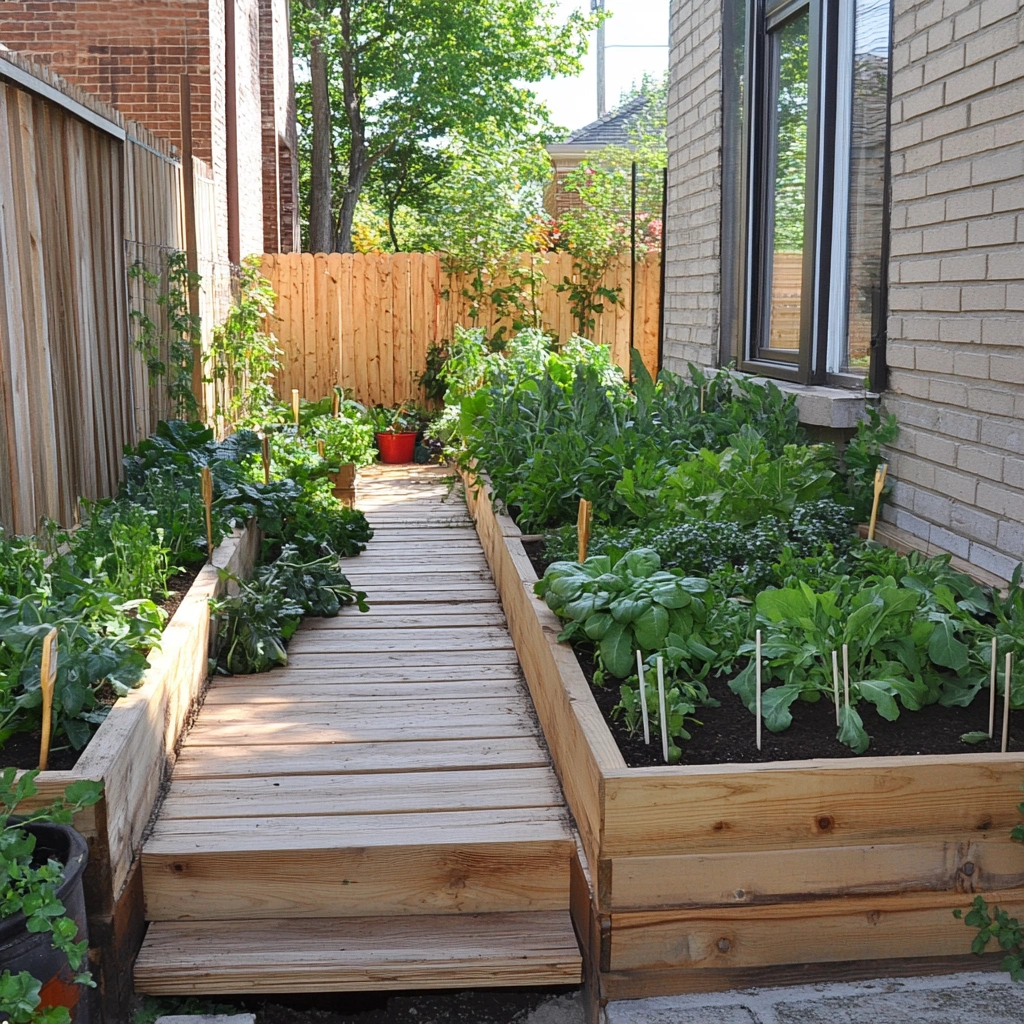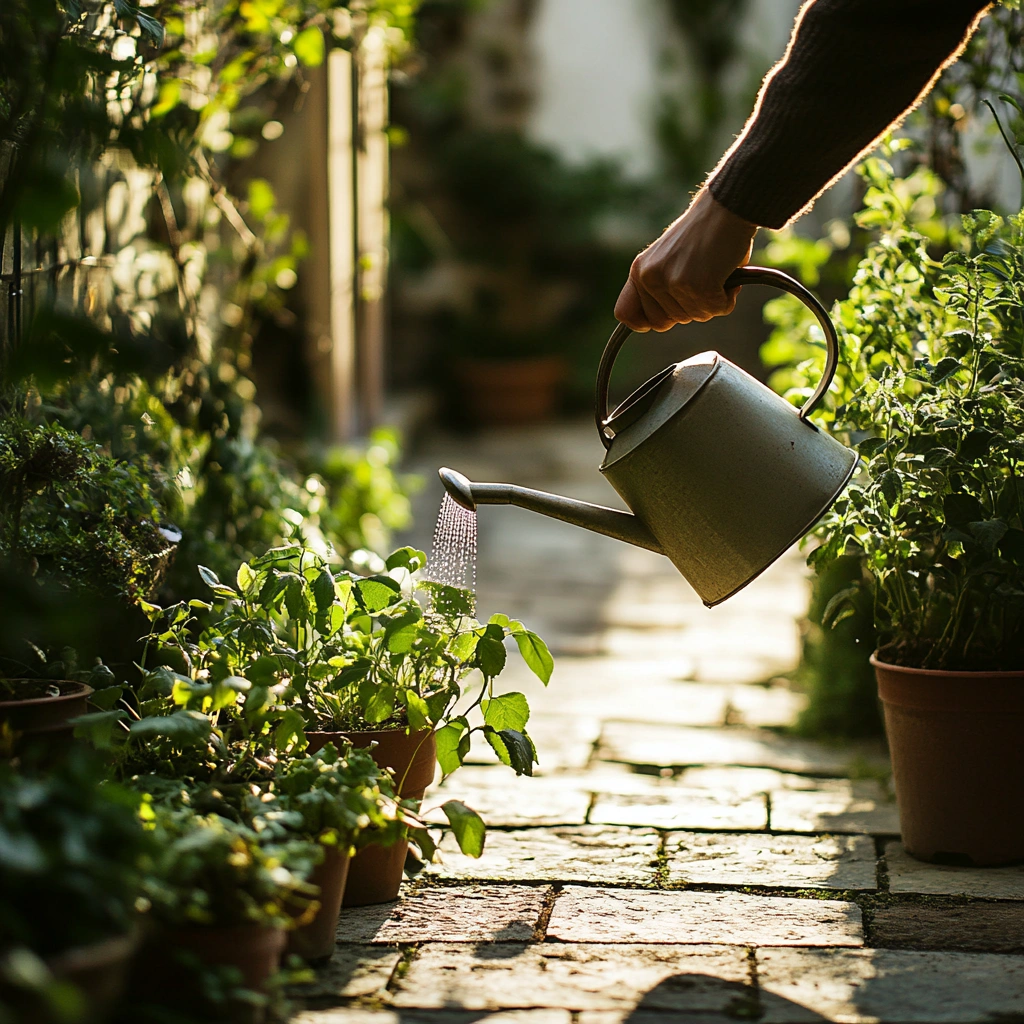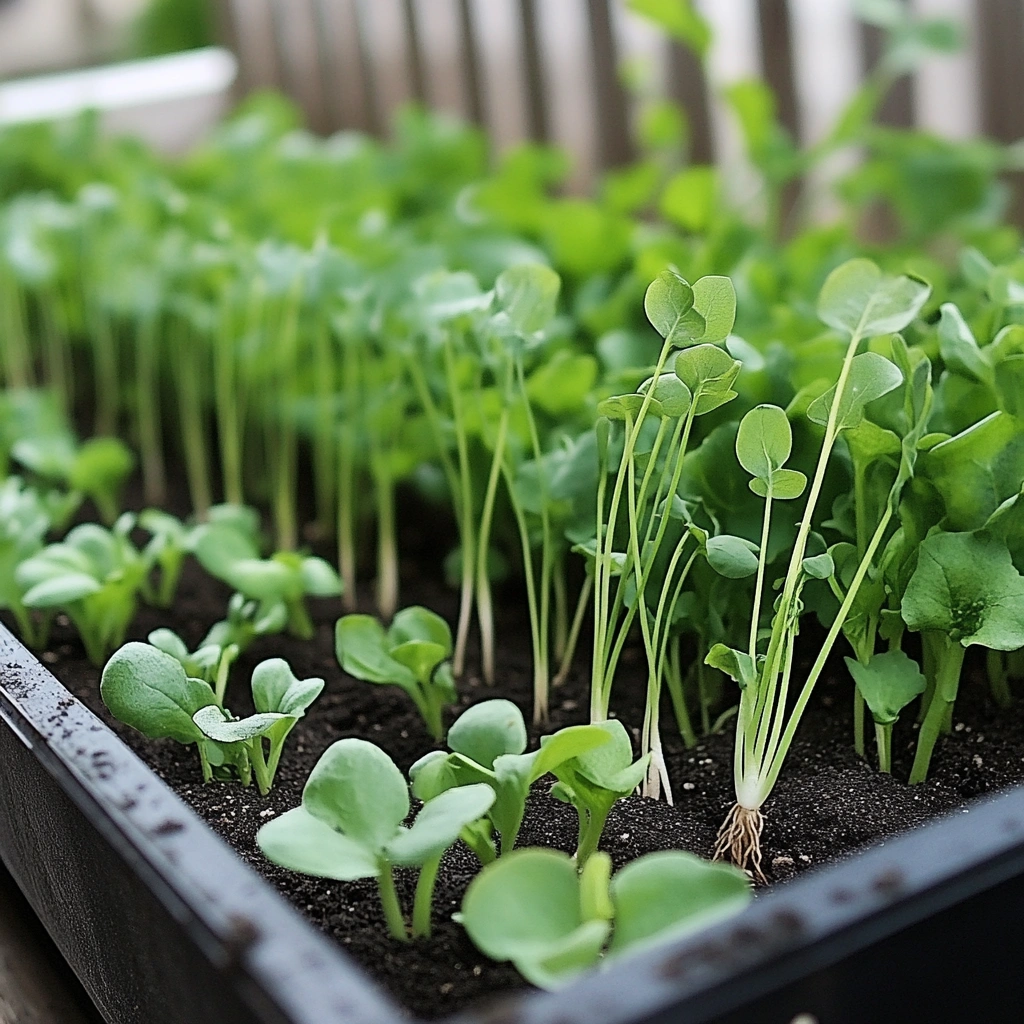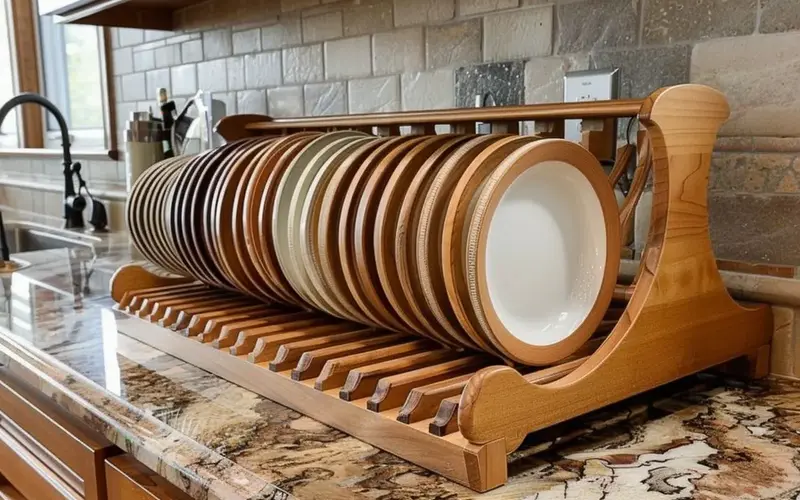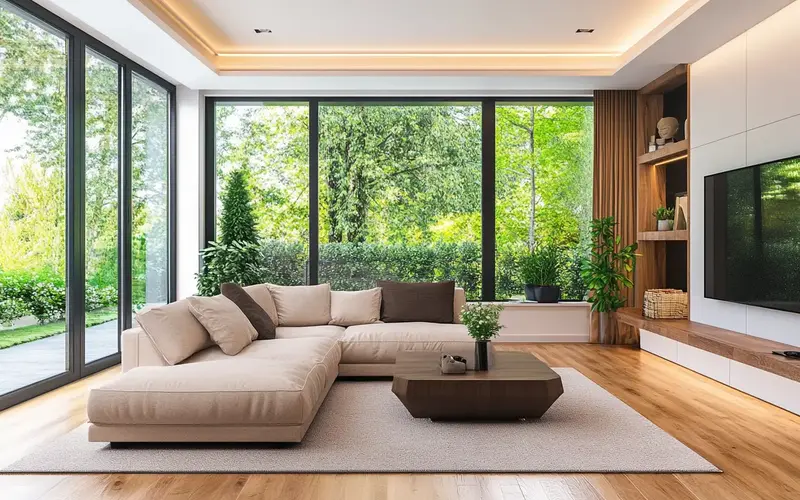Hey there, fellow plant lovers! Ever stare longingly at those sprawling garden photos on Pinterest, then glance at your petite patio and sigh? Yeah, me too. But guess what? You absolutely do not need a sprawling backyard to enjoy the unparalleled joy (and taste!) of homegrown veggies.
Forget what the gardening gurus tell you about acres and vast plots; we’re taking back the urban jungle, one tiny tomato plant at a time. So, grab your favorite mug, settle in, and let’s chat about transforming your small outdoor nook into a vibrant, delicious veggie haven. Are you ready to get your hands a little dirty?
Stacking Planters
The Inspiration: You stare at your patio, wondering how to fit more green goodness without sacrificing precious walking space. Suddenly, it hits you: if you can’t go out, go up! The idea of stacking things, like cute little plant condos, just makes so much sense when space is at a premium. Why use one footprint when you can use… three? Or four? It’s basically real estate development for plants.
Why it works: These clever planters let you grow multiple plants in a fraction of the ground space. Think of them as vertical apartment complexes for your herbs, strawberries, or even a few smaller leafy greens. You maximize your growing area without turning your patio into an impassable jungle.
Pro Tip: Choose stacking planters with a good drainage system for each tier. This prevents root rot in the lower levels, ensuring all your green residents thrive, not just the penthouse dwellers.
Read More: 21 Inspiring Vegetable Garden Design Ideas
Vertical Garden Towers
The Inspiration: We all dream of those lush, green walls you see in fancy magazines, right? But then reality bites, and you realize you have zero construction skills. Enter the ready-made vertical garden tower, a brilliant solution for those of us who want the look without the DIY disaster. You crave a cascade of cucumbers, but you also want to eat them, not just admire a half-built trellis.
Why it works: These pre-made towers are specifically designed for compact spaces and come in various shapes and sizes. Many even boast fancy self-watering systems, which, let’s be honest, is a godsend for busy folks who occasionally forget to water their plants until they look like crispy critters. You can pack a surprising variety of vegetables into one of these bad boys, from lettuce to strawberries.
Pro Tip: Rotate your vertical garden tower every few days if one side gets significantly more sun. This ensures all your plants receive equal light, preventing uneven growth and grumpy-looking veggies.
Read More: How to Design a Container Garden for Your Flowers
Wall-Mounted Planters
The Inspiration: Your walls are just… there. Empty. Mocking your attempts at a sprawling garden. But what if those blank canvases could be transformed into edible art? You suddenly picture vibrant green leaves and colorful tomatoes hanging elegantly, making your patio feel less like a forgotten corner and more like a living masterpiece.
Why it works: Attaching planters directly to a sturdy wall or fence turns unused vertical space into a productive growing area. This creates a visually stunning “living wall” of edibles, adding charm and functionality. Just make sure you pick lightweight containers; you don’t want your wall suddenly developing a plant-related structural issue, do you?
Pro Tip: Before mounting, check for proper drainage holes in your chosen containers to avoid waterlogged roots. Also, consider the weight of the soil and mature plants when selecting your wall fasteners; gravity is a harsh mistress.
Read More: 17 Garden Ideas for Small Spaces and Maximum Yield
Hanging Baskets
The Inspiration: You look up, and there’s all this air just sitting there, doing nothing. It feels like wasted potential, doesn’t it? You imagine juicy cherry tomatoes dangling tantalizingly, or sweet strawberries just begging to be picked, all floating above the ground. It’s like magic, but with dirt.
Why it works: Hanging baskets are fantastic for growing cherry tomatoes, strawberries, or various cascading herbs. They ingeniously free up valuable floor space, which is like finding extra square footage you didn’t even know you had! Plus, they add a lovely visual element, making your patio feel lush and inviting.
Pro Tip: Choose self-watering hanging baskets or line them with a moisture-retaining material like coconut coir to prevent them from drying out too quickly, especially on hot, sunny days. Nobody likes a thirsty plant, especially when it’s dangling over your head.
Read More: Stunning Flower Bed Ideas for the Front of the House
Fabric Grow Bags
The Inspiration: You’ve seen those clunky ceramic pots, heavy as sin, and probably more expensive than they have any right to be. Then you stumble upon fabric grow bags, and a lightbulb goes off. Lightweight? Affordable? And they let the roots breathe? It’s like the comfy sweatpants of the gardening world – surprisingly effective and utterly practical.
Why it works: These bags are remarkably lightweight, breathable, and incredibly affordable. They are particularly brilliant for root vegetables like potatoes, carrots, and onions because they promote something called “air pruning.” This fancy term means the roots naturally branch out more efficiently, leading to a healthier root system and, ultimately, a happier plant (and bigger veggies!).
Pro Tip: For larger root vegetables like potatoes, opt for a 10-gallon or larger fabric grow bag. This gives the spuds ample room to grow and develop without feeling squished.
Read More: Amazing Herb Garden Ideas for Your Outdoor Oasis
Self-Watering Planters
The Inspiration: Let’s be real, daily watering is a chore. You love your plants, but sometimes you just want to sleep in, or, you know, live your life. The thought of a planter that waters itself is like discovering a secret garden hack – pure genius. It’s the closest you’ll get to having a personal plant assistant.
Why it works: Self-watering planters come with a built-in reservoir that slowly releases water to your plants as they need it. This dramatically minimizes your daily watering chores, which is a blessing for busy gardeners (or those who just occasionally forget to water, no judgment here!). They also help prevent both underwatering and the dreaded overwatering, which can lead to root rot.
Pro Tip: Use a lightweight, well-draining potting mix in self-watering planters. This prevents the soil from becoming waterlogged in the reservoir and ensures optimal aeration for your plant’s roots.
Read More: 21 Stunning Mediterranean Garden Ideas To Inspire You
Repurposed Containers
The Inspiration: You look around your home and see potential everywhere – old buckets, discarded plastic tubs, maybe even a sturdy laundry basket that’s seen better days. Why buy new when you can give something a second life? It’s eco-friendly, budget-friendly, and honestly, a little bit rebellious. Who needs fancy pots when you have imagination?
Why it works: Getting creative with repurposed containers is a fantastic way to garden on a dime. Old buckets, plastic tubs, or even sturdy laundry baskets can become excellent plant homes, as long as you remember one crucial step: adding drainage holes! This is not just a budget-friendly option but also a wonderfully sustainable one, reducing waste and giving new purpose to old items.
Pro Tip: When drilling drainage holes in repurposed plastic containers, use a drill bit specifically designed for plastic to prevent cracking. Aim for several small holes rather than one large one for better drainage.
Read More: How To Create a Magical DIY Fairy Garden for Your Backyard
Railing Planters
The Inspiration: Your patio railing is just… sitting there. A perfectly good surface, completely unused for growing. It’s like a missed opportunity. You envision a row of vibrant herbs or cheerful flowers transforming your otherwise mundane railing into a lush, green border. Why leave it bare when it could be bursting with life?
Why it works: Railing planters cleverly hang directly over your patio railing, instantly utilizing otherwise unused vertical space. This is prime real estate you might have completely overlooked! They add a delightful pop of greenery and can be perfect for smaller herbs, flowers, or even a few compact leafy greens. Just make sure they are secure and can handle the weight of soil and water.
Pro Tip: Choose railing planters with adjustable hooks or brackets to ensure a snug and secure fit on your specific railing. This prevents wobbling or accidental spills, especially on windy days.
Read More: How To Create a Beautiful Rose Garden To Inspire You
Companion Planting
The Inspiration: You’ve heard whispers of plants helping other plants, like a secret society of horticultural helpers. It sounds a bit like magic, but then you realize it’s just good old-fashioned nature. You want your tomatoes to thrive, and if a marigold can help out, why not invite it to the party? It’s like setting up your plants on a friendly playdate.
Why it works: Strategically planting compatible vegetables together can work wonders for your garden. This technique, known as companion planting, helps deter pests naturally and can even improve the growth and flavor of your plants. For instance, planting marigolds near tomatoes can help protect them from pesky nematodes, giving your tomatoes a better chance at a delicious life. It’s like having tiny, adorable bodyguards for your produce.
Pro Tip: Research companion plant pairings specific to the vegetables you plan to grow. Not all plants are friendly neighbors; some can hinder each other’s growth, so do your homework!
Square Foot Gardening Principles
The Inspiration: You look at your small raised bed, or even a large container, and wonder how to squeeze every last bit of productivity out of it. The idea of mapping it out, like a tiny grid, feels wonderfully organized and efficient. It’s gardening for the highly methodical, or those of us who just want more lettuce.
Why it works: This method involves dividing your raised beds or large containers into square-foot sections, allowing you to maximize your yield in a surprisingly small area. Square foot gardening promotes intensive planting, meaning you can grow more food in less space by carefully planning where each plant goes. It’s incredibly efficient and surprisingly satisfying when you see how much you can harvest from such a small plot.
Pro Tip: Create a simple grid on your planting area using string or thin wooden strips. This visual guide makes it easy to stick to the square-foot planting density and avoid overcrowding.
Succession Planting
The Inspiration: You love fresh lettuce, but you don’t need 50 heads of it all at once, right? The thought of a continuous harvest, a steady stream of fresh greens and veggies, sounds much more appealing than one massive, overwhelming glut. It’s like having a never-ending buffet from your own patio.
Why it works: Succession planting involves planting small batches of quick-growing vegetables every few weeks. This genius technique ensures a continuous harvest throughout the growing season, preventing an overwhelming bounty all at once (because who needs that many radishes at one time?). It means you’ll always have fresh produce readily available, and your fridge won’t be overflowing with a single crop.
Pro Tip: Keep a simple planting calendar to track when you sowed each batch of seeds. This helps you remember when to plant the next round and ensures a steady supply of your favorite veggies.
Hydroponic Systems (Small Scale)
The Inspiration: You’ve heard about soil-free gardening, and it sounds a little futuristic, a little complicated. But then you see those sleek, compact hydroponic units designed for small spaces, and suddenly, growing lettuce on your countertop without dirt seems entirely plausible, and even a bit cool. It’s like bringing a bit of NASA to your kitchen.
Why it works: Consider a compact hydroponic system for a soil-free alternative, especially for leafy greens and herbs. These systems deliver nutrient-rich water directly to the plant roots, often using significantly less water than traditional soil gardening. They can be incredibly efficient, leading to faster growth and bigger yields in a minimal footprint. Plus, no messy soil!
Pro Tip: Start with a simple, ready-to-assemble hydroponic kit designed for beginners. This helps you get a feel for the system without investing in complex setups right away.
Portable Potting Bench
The Inspiration: You’re tired of hunching over a tiny table, making a mess on your patio, and scattering potting mix everywhere. The idea of a dedicated, tidy workspace that you can tuck away when not in use is pure bliss. It’s like having a miniature, mobile gardening studio.
Why it works: A small, foldable potting bench provides a designated, comfortable workspace for all your planting and maintenance tasks. This keeps your patio tidy and organized, preventing soil spills and scattered tools. When you’re done, you can often fold it up and store it away, reclaiming your patio for relaxation or other activities.
Pro Tip: Choose a potting bench with built-in storage shelves or hooks for small tools. This keeps everything you need within arm’s reach and further enhances organization.
Small Watering Can with a Fine Rose
The Inspiration: You’ve probably tried to water your delicate seedlings with a hose, only to realize you’ve just created a mini-tsunami. Or perhaps your big, clunky watering can drenches your patio more than your plants. You need precision, a gentle touch, something that says, “I care about your roots, tiny plant.”
Why it works: A precise watering can, ideally with a fine rose (that’s the sprinkler-like attachment), helps you deliver water directly to the plant roots without over-saturating the surrounding patio. This is especially crucial for container plants, where precise watering prevents both wasted water and soggy soil that can lead to root rot. It’s like targeted hydration for your green babies.
Pro Tip: Always check the soil moisture before watering. Stick your finger about an inch or two into the soil; if it feels dry, then water. Don’t just water on a schedule.
Compact Gardening Tools
The Inspiration: Your garage is overflowing with oversized shovels and rakes meant for a full-blown yard. But you’re gardening in a teacup, practically! You need tools that are nimble, easy to store, and don’t make you feel like you’re trying to dig a ditch with a bulldozer.
Why it works: Investing in hand trowels, pruners, and cultivators specifically designed for small spaces makes a world of difference. These tools are much easier to store in a confined area, and their size allows for better maneuverability in your pots and small beds. They make light work of planting, weeding, and pruning, preventing unnecessary frustration.
Pro Tip: Look for compact gardening tools made from durable stainless steel. They will last longer and resist rust, standing up to the rigors of urban gardening.
Rolling Plant Caddies
The Inspiration: That huge pot of tomatoes is heavy. Like, heavy. And trying to drag it across your patio to catch the afternoon sun, or worse, to get it out of the way for a social gathering, is an Olympic sport you didn’t sign up for. You wish your plants just had wheels. Wait, they can!
Why it works: Placing heavy pots on caddies with wheels is a game-changer for patio gardeners. This simple solution allows you to effortlessly move plants for optimal sunlight exposure throughout the day or quickly bring them indoors when unexpected harsh weather hits. It protects your back from strain and prevents unsightly scratches or stains on your patio surface.
Pro Tip: Choose rolling plant caddies with sturdy, lockable wheels. This ensures your plants stay put when you want them to and prevents them from rolling away in a strong gust of wind.
Bush Varieties of Tomatoes
The Inspiration: You dream of fresh, juicy tomatoes, but those sprawling vines that take over entire gardens? Not for your patio. You want the taste, without the jungle. The idea of a compact, polite tomato plant that knows its boundaries is incredibly appealing.
Why it works: Opting for determinate or “bush” varieties of tomatoes is a must for small-space gardening. These types are naturally more compact and don’t require the extensive staking and pruning that vining (indeterminate) tomatoes demand. They produce their fruit in a concentrated burst, making them perfect for container growing on your patio without overwhelming your limited space.
Pro Tip: Even bush tomatoes can benefit from a small cage or stake to support their fruit-laden branches. This prevents them from flopping over and keeps the produce off the ground.
Compact Cucumber Varieties
The Inspiration: You love cucumbers, but those sprawling vines usually need an entire farm to themselves. You want crisp, homegrown cukes for your salads, but you also want to be able to walk on your patio. The thought of a cucumber plant that behaves itself and stays relatively contained is a revelation.
Why it works: Seek out “bush” or “patio” cucumber varieties specifically bred for smaller spaces. These produce shorter vines compared to their sprawling cousins, making them much more manageable for containers. You can grow them in a decent-sized pot, or even train them vertically on a small trellis or cage, maximizing your yield without hogging your entire patio.
Pro Tip: Provide a small trellis or support for even “bush” cucumber varieties. While compact, their fruit can still get heavy, and a little support will keep them healthy and off the ground.
Dwarf Pepper Plants
The Inspiration: You crave the vibrant colors and zesty flavor of fresh peppers, but you’re not planning to open a salsa factory. You need a pepper plant that fits neatly into a pot, produces a decent harvest, and doesn’t require its postcode.
Why it works: Many pepper varieties naturally come in dwarf or compact forms, making them exceptionally well-suited for container gardening. They produce a good yield of delicious peppers without taking up much precious space. From bell peppers to fiery jalapeños, you can find a dwarf variety to satisfy your taste buds and fit perfectly on your patio.
Pro Tip: Provide your dwarf pepper plants with plenty of sunlight – at least 6-8 hours of direct sun per day. More sun generally equals more peppers!
Radishes and Green Onions
The Inspiration: You’re eager for that instant gratification, that feeling of harvesting something fresh from your garden, fast. Long waits for harvests can be a buzzkill. But radishes and green onions? They practically grow while you watch, offering a quick reward for your gardening efforts. It’s like the fast food of gardening, but way healthier.
Why it works: Radishes and green onions are fantastic for small-space gardening because they are incredibly quick-growing and have shallow root systems. You can harvest radishes in as little as 3-4 weeks from planting, and green onions are constantly available for snipping. They are ideal for filling small gaps in your garden, offering a rapid turnaround and continuous fresh flavor.
Pro Tip: Plant small batches of radishes and green onions every week or two (succession planting, remember?). This ensures a steady supply and prevents you from having too many at once.
Leafy Greens (Lettuce, Spinach, Arugula)
The Inspiration: Fresh salads, straight from your patio, every day? Yes, please! You want that crisp, vibrant taste without the grocery store trip. And the idea of being able to snip off just what you need, right when you need it, feels incredibly luxurious and convenient.
Why it works: Leafy greens like lettuce, spinach, and arugula are perfect for container gardening. They thrive in pots and offer the wonderful benefit of being “cut-and-come-again” crops. This means you can harvest the outer leaves as needed, and the plant will continue to produce new growth, providing you with a continuous supply of fresh greens throughout the season.
Pro Tip: Grow a variety of leafy greens with different textures and flavors to create your custom salad mixes. Don’t be afraid to mix things up!
Final Thoughts
See? Transforming a small patio into a super productive, delicious vegetable garden isn’t just a pipe dream; it’s achievable! You’ve got all the tools and tricks now to overcome those pesky space constraints and truly enjoy the satisfaction of harvesting fresh, homegrown produce right outside your door. So go on, embrace your inner urban farmer, get creative, experiment with these genius techniques, and watch your compact veggie patch flourish. Happy growing, friends!
